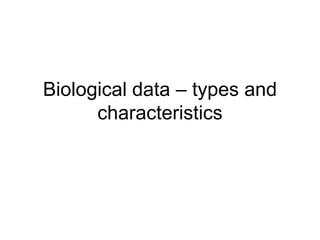Biological data – types and characteristics.ppt
•Download as PPT, PDF•
0 likes•971 views
Bioinformatics
Report
Share
Report
Share

Recommended
More Related Content
What's hot
What's hot (20)
Phylogenetic tree and its construction and phylogeny of

Phylogenetic tree and its construction and phylogeny of
Primary and secondary databases ppt by puneet kulyana

Primary and secondary databases ppt by puneet kulyana
Similar to Biological data – types and characteristics.ppt
Similar to Biological data – types and characteristics.ppt (20)
Topic 1 - Scales of Measurement & Distributions.pptx

Topic 1 - Scales of Measurement & Distributions.pptx
Finding and Using Secondary Data and Resources for Research

Finding and Using Secondary Data and Resources for Research
More from Swaminathan34154
More from Swaminathan34154 (8)
3 & 4 T. AGM Significance of Microbial spoilage of food.pptx

3 & 4 T. AGM Significance of Microbial spoilage of food.pptx
2T. AGM Physical and chemical changes during food spoilage.pptx

2T. AGM Physical and chemical changes during food spoilage.pptx
Recently uploaded
Recently uploaded (20)
Human & Veterinary Respiratory Physilogy_DR.E.Muralinath_Associate Professor....

Human & Veterinary Respiratory Physilogy_DR.E.Muralinath_Associate Professor....
Thyroid Physiology_Dr.E. Muralinath_ Associate Professor

Thyroid Physiology_Dr.E. Muralinath_ Associate Professor
Gwalior ❤CALL GIRL 84099*07087 ❤CALL GIRLS IN Gwalior ESCORT SERVICE❤CALL GIRL

Gwalior ❤CALL GIRL 84099*07087 ❤CALL GIRLS IN Gwalior ESCORT SERVICE❤CALL GIRL
Role of AI in seed science Predictive modelling and Beyond.pptx

Role of AI in seed science Predictive modelling and Beyond.pptx
The Mariana Trench remarkable geological features on Earth.pptx

The Mariana Trench remarkable geological features on Earth.pptx
Cyathodium bryophyte: morphology, anatomy, reproduction etc.

Cyathodium bryophyte: morphology, anatomy, reproduction etc.
Bhiwandi Bhiwandi ❤CALL GIRL 7870993772 ❤CALL GIRLS ESCORT SERVICE In Bhiwan...

Bhiwandi Bhiwandi ❤CALL GIRL 7870993772 ❤CALL GIRLS ESCORT SERVICE In Bhiwan...
Site specific recombination and transposition.........pdf

Site specific recombination and transposition.........pdf
THE ROLE OF BIOTECHNOLOGY IN THE ECONOMIC UPLIFT.pptx

THE ROLE OF BIOTECHNOLOGY IN THE ECONOMIC UPLIFT.pptx
Genome organization in virus,bacteria and eukaryotes.pptx

Genome organization in virus,bacteria and eukaryotes.pptx
Biological data – types and characteristics.ppt
- 1. Biological data – types and characteristics
- 2. What is Data? • Data is a collection of facts, such as values or measurements. • It can be numbers, words, measurements, observations or even just descriptions of things.
- 3. General • DATA - Numbers or other identifiers derived from observation, experiment or calculation • INFORMATION - a collection of data and associated explanations, interpretations, and other material concerning a particular object, event or process
- 4. Classification • Primary vs Secondary • Qualitative vs Quantitative
- 5. Primary Data • Data that has been collected from first- hand-experience is known as primary data. • Primary data has not been published yet and is more reliable, authentic and objective. Primary data has not been changed or altered by human beings, therefore its validity is greater than secondary data.
- 6. Sources of Primary Data • Experiments • Survey – Questionnaire – Interview – Observations
- 7. Secondary Data • Data collected from a source that has already been published in any form is called as secondary data. • The review of literature in nay research is based on secondary data. Mostly from books, journals and periodicals.
- 8. Sources of Secondary Data • Published Printed Sources: • Books: • Journals/periodicals • Magazines/Newspapers • e-journals • General websites
- 9. Sources of data • Sequencing programs • Molecular studies • Elucidation of metabolic pathways / Cellular mechanisms • Cytological studies • Clinical studies • Physiological studies • Mutational experiments • Data from simulation
- 10. Qualitative vs Quantitative • Data can be qualitative or quantitative. • Qualitative data is descriptive information (it describes something) • Quantitative data, is numerical information (numbers). •
- 11. • And Quantitative data can also be Discrete or Continuous: • Discrete data can only take certain values (like whole numbers) • Continuous data can take any value (within a range)
- 12. Qualitative: He is brown and black He has long hair He has lots of energy Quantitative: Discrete: He has 4 legs He has 2 brothers Continuous: He weighs 25.5 kg He is 565 mm tall Discrete data is counted, Continuous data is measured
- 13. Types of data • Morphological • Sequence • Structure
- 14. General characteristics • Diversity – are intrinsically complex and are organized in loose hierarchies that reflect our understanding of the complex living systems, ranging from gene and proteins, to protein-protein interactions, biochemical pathways and regulatory networks, to cells and tissues, organisms and populations • Variability - Different individuals and species vary tremendously, so naturally biological data does also
- 15. • Non reproducibility – Representations of the same data by different biologists will most likely be different (even when using the same system) • Redundancy – Lack of uniqueness
- 16. The importance of biological data • Data has become an essential commodity for biological research. • Ten years ago, if a medical researcher needed to find a gene involved in a certain disease, he or she might have needed to invest 3 years of laboratory work. • Today, thanks to genomic information stored in large public databases, the same task may take less than 30 minutes.